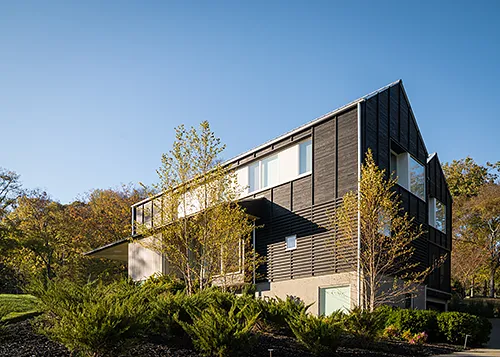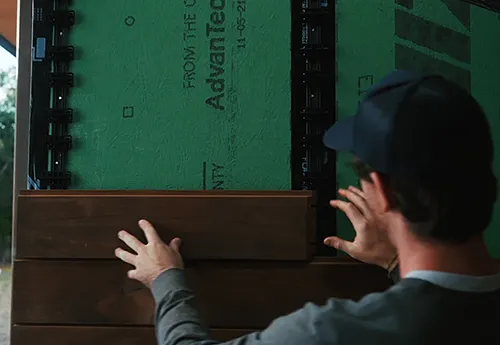by Rachel Lyon, Editorial Director for The House Designers
If you have trouble when it comes time to choose exterior products for your home, you’re not alone. There are so many different materials you can use, and most of them have pros, cons, and specific installation requirements that may swing your opinion one way or another. Homeowners often default to some type of siding to finish their exterior walls, but cladding also makes a very sound or even better choice. You may never have heard of a rainscreen before, but here’s how rainscreen cladding stacks up and why it could be the answer you’ve been looking for!

Cladding vs. Siding
You might think these terms are synonymous, but they aren’t! While both are applied to exterior walls to protect the home’s interior, siding is nailed down directly to the house while cladding is attached to thin furring strips that have been nailed into the house. Both are done over waterproof sheathing, but there’s a big functional difference. Siding is made to overlap and sock down directly against the sheathing while pieces of cladding don’t overlap, so they leave a small gap between the wall surface and the cladding. This gap is called a rainscreen.
Like siding, cladding comes in a variety of different materials and looks, but not all types of “cladding” create a rainscreen. So, don’t think that stone or brick cladding applied with regular masonry techniques will have the same performance. Most rainscreen cladding products clearly state what they are, but you always need to research and confirm that you’re purchasing exactly what you want.

Rainscreen Benefits
What makes a rainscreen so desirable? Simply put, it provides a natural way for your home’s exterior to release moisture intrusion, which lessens the risk of mold and rot compared to siding. Cladding protects a house from the elements like you’d expect from any other product, so think of the rainscreen as just an extra layer of insurance. Any water that happens to get behind it can easily drain out at the bottom of the wall or evaporate out at the top. On the other hand, water that intrudes behind siding often gets trapped, and it can easily permeate the waterproof sheathing at the nail sites and seep into insulation and framing. This compromises the integrity of the house and leads to costly repairs, of course, but it can also take a toll on your health. Ask anybody who’s had to contend with this problem and they will recommend going the ounce of prevention route.
Rainscreen cladding is suitable for any location, but you’ll see it used most often in wet climates where moisture intrusion is practically inevitable. Homes in places that experience heavy, wind-driven rain are the most at risk because sheets of rain coming in from the side will push moisture into any cracks it can find. So, if you plan to build along a coastline or other body of water, in an area that experiences powerful storms, or somewhere that’s just damp a lot of the time, cladding is ideal to help protect your investment and provide greater peace of mind.

Types of Cladding
Whatever sort of style you have in mind, you can find cladding to complement it! Wood is the most adaptable by far, which is why you’ll see it used across whole homes and as an accent with other materials. This nifty product can be installed horizontally, vertically, or even at an angle if you want to add extra interest to your exterior design. You’ll also find rustic and sophisticated options to suit different types of architecture. One of the latest innovations in rainscreen cladding is a system that even does away with the regular furring strips, replacing them with a metal track that takes the guesswork out of placement and makes it possible to clad a wall faster than ever before. That’s good news for you and your builder, because they can finish sooner and pass those labor savings on. It has never been so easy to outfit a home with cladding before!
If a rainscreen appeals to you and you’re in the market for cladding, take a look at what Kebony® has to offer. Their products are all made from sustainably harvested pine, but each plank has undergone a special modification process that increases the thickness of the wood’s cell walls. This means Kebony Cladding rivals tropical hardwoods when it comes to durability, and you can expect it to protect your home for decades with zero maintenance. You can find a local dealer or buy direct, so reach out today to get started outfitting your home!